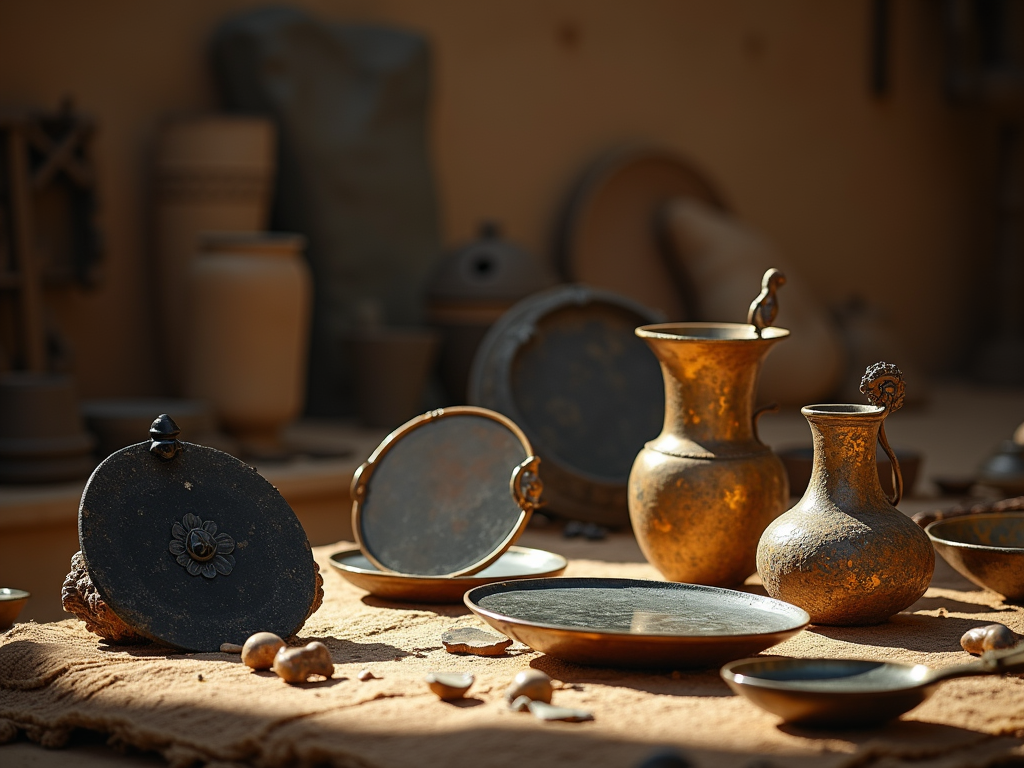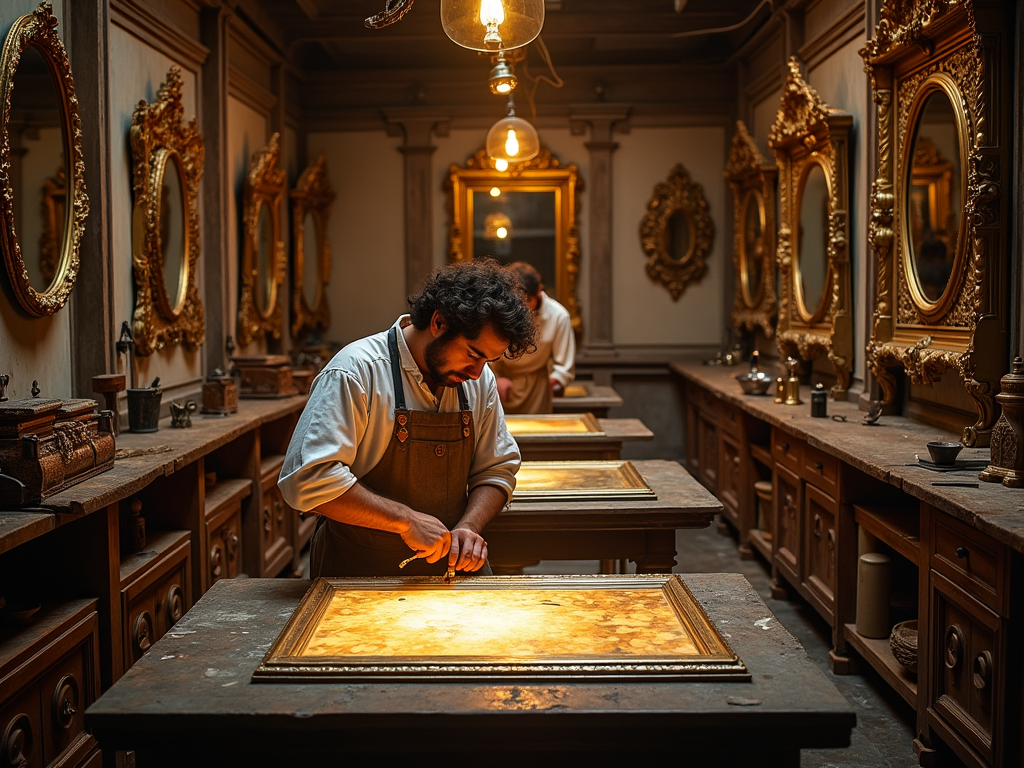
The mirror’s origins trace back to 6000 BC, where polished obsidian served as the first reflective surface in Anatolia. Over time, technologies evolved, turning basic reflective tools into essential and decorative household items. Innovations like Venetian artistry and the introduction of silvering reshaped how mirrors were crafted and used.
Key Takeaways
- Around 6000 BC in Anatolia, polished obsidian provided the first reliable reflective surfaces.
- Polished copper and bronze, used by Ancient Egyptians and Mesopotamians from the 4th and 3rd millennia BC, marked the development of more functional but less distinct reflections.
- In the 1st century AD, Romans advanced mirror-making with blown glass backed by metal, creating clearer and brighter images.
- Venetian craftsmen during the Renaissance refined mirrors, using tin-mercury amalgam and transforming them into symbols of wealth and artistry.
- The silvering technique, introduced in the 19th century by Justus von Liebig, significantly improved mirror production, making them more functional, longer-lasting, and accessible for both homes and industries.
From Obsidian to Metal: The First Attempts at Reflection
Before humans had access to crafted mirrors, they used natural pools of water to catch a glimpse of themselves. The ripples and interruptions in the water made these reflections fleeting and unreliable, but it was a starting point. By around 6000 BC, people in Anatolia, now part of modern-day Turkey, began polishing volcanic glass called obsidian to create the first intentional reflective surfaces. These obsidian mirrors were dark and small, but they provided stability water couldn’t offer.
By the 4th and 3rd millennia BC, cultures such as the ancient Egyptians and Mesopotamians pushed the concept further by shaping reflective metals like copper and bronze into mirrors. Egyptians, for instance, often crafted elegant handheld pieces with detailed handles, while Mesopotamians leaned on practical utility. These metal mirrors, though an improvement, lacked clarity. Their surfaces reflected light but often produced a dim, slightly distorted image compared to today’s glass-and-silver options. Regular polishing was necessary to maintain effectiveness, and scratches could easily compromise their use.
I find it fascinating how these societies overcame material challenges and limited technology to create tools that satisfied a universal curiosity about self-image. From obsidian’s volcanic origins in Anatolia to the hot sands of Egypt and the fertile lands of Mesopotamia, each region left its mark on early innovation. It’s leaps like these that show how inventive humanity has always been, even with basic materials. If you’re curious, check out this look at the real color of a mirror for more on their evolution!

The Roman Leap: Glass Mirrors Begin to Shine
The first glass mirrors took shape during the Roman Empire, emerging around the 1st century AD. This breakthrough followed advancements in glassblowing, a technique pioneered in the Syrian region by about 50 BC. Roman artisans paired this new skill with metallic backings like lead or tin, creating mirrors that far surpassed the reflective quality of polished metals.
Crafting glass in this era posed its own set of challenges. Glassblowing was still relatively new, and achieving uniform thickness in the blown glass was difficult. Even so, Romans refined the process enough to produce thin, flat sheets for mirror-making. To enhance reflectivity, they coated the back of these sheets with layers of metal, which dramatically improved the clarity of reflected images compared to earlier mirrors made from materials such as polished bronze or obsidian.
Here’s how these Roman innovations stacked up:
- Earlier polished metal mirrors: Bronze, copper, and even silver were commonly used before glass mirrors. They reflected light poorly, showing dim or blurry images that required constant polishing.
- Roman glass mirrors: By combining glass and metals, Romans achieved brighter and sharper reflections. This represented a leap in both practicality and aesthetics, especially compared to their predecessors.
That combination of glass and metallic backing set the foundation for modern mirror-making. Over time, these techniques continued to develop, eventually leading to the precise mirrors we use today. If you’re curious about mirror trivia like “what color is a mirror,” you’ll find more details in related explorations of mirror craftsmanship.
The Venetian Revolution: Mirrors as Luxury Art
During the Renaissance, Venice became the epicenter of mirror innovation and craftsmanship. Venetian artisans brought an extraordinary level of artistry to mirror-making. They perfected the use of a tin-mercury amalgam backing, which gave mirrors unrivaled clarity and reflectivity at the time. This method represented a leap forward compared to earlier polished metals or blown glass mirrors, which often left images dim and distorted. Artisans in Venice turned what had been functional objects into exquisite luxury creations.
The chemistry behind the tin-mercury process is what set Venetians apart. By coating a glass pane with a thin mixture of tin and liquid mercury, they achieved highly reflective surfaces that were smooth and brighter than anything seen before. This innovation required skill and precision, as the technique was both time-consuming and delicate.
Venetian mirrors were far more than tools for reflection. Elaborate designs included gilded frames, hand-carved floral patterns, and intricate engravings. Some were surrounded by ornately painted wood or inlaid with precious materials like mother-of-pearl. These mirrors quickly became symbols of wealth and status, adored by European aristocracy. Nobles prized them as much for their artistry as their function, often commissioning custom pieces to adorn grand salons.
Even hanging one of these masterpieces emphasized its importance. If you’re looking for inspiration on perfect mirror placement, consider checking out how to hang a heavy mirror for modern insights with historical inspiration. Venetian mirrors set the gold standard during the Renaissance for aesthetics and craftsmanship.

A 19th-Century Breakthrough: Silvering Glass
Justus von Liebig completely changed mirror production in the 1830s with his silvering process. Unlike earlier methods that relied on fragile tin-mercury amalgams, Liebig’s innovation involved applying a thin layer of metallic silver to glass. This method wasn’t just a leap in efficiency—it made mirrors sturdier, far more reflective, and much cheaper to produce. For the first time, mirrors became a household standard rather than a luxury.
The silvering process itself is fascinating. Liebig discovered how to coat glass with a silver nitrate solution. Through a controlled chemical reaction involving formaldehyde or another reducing agent, the nitrate was reduced to metallic silver, forming an even, reflective surface on the glass. This simple yet brilliant method improved the durability and brightness of mirrors, outclassing older techniques that often tarnished over time.
This breakthrough didn’t just change home décor—it reshaped industries and science. Modern mirrors, based on Liebig’s principles, are essential in fields like astronomy, where precise reflective surfaces enable groundbreaking telescope designs. Industries like solar energy also rely on highly reflective mirrors to optimize efficiency in solar panels. Even something as everyday as hanging mirrors in your home owes its practicality to this process. If you’ve ever wondered what color a mirror is, silvering glass answers that question with its distinct metallic hue.
Liebig’s innovation wasn’t only transformative in its time; its effects ripple across disciplines even today.
Today’s mirrors feature a backing of silver or aluminum for their excellent reflectivity and reasonable cost. Their function has expanded far beyond personal grooming or home décor. In science, mirrors are critical for precise instruments like telescopes, helping capture the faint glow of distant stars. In cars, rearview mirrors boost safety, offering quick visibility of surroundings. They’re also key in solar panels, where reflective technology enhances energy efficiency.
This progression mirrors human innovation itself—moving from polished stone in ancient times to tools that define modern convenience and advanced technology. Whether it’s ensuring a balanced home aesthetic, like knowing what color a mirror truly reflects, or contributing to life-changing fields, mirrors remain indispensable. Their role isn’t static; they grow and adapt alongside technological advancements, proving just how impactful such a seemingly simple invention can be.

Sources:
Blank
